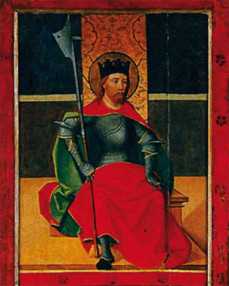The canonization of King Stephen I on 20th August 1083
Szöveg: hungariandefence.com | 2011. augusztus 20. 8:04Nine hundred and twenty-eight years ago, on August 20, 1083 King Stephen was canonized. We commemorate the historic event by excerpting from the publication of the Zrínyi Média MoD Communications Ltd., entitled: ‘For the Homeland Unto Death – 1100 years’, which is available in our digital library.

canonisation is the legend of Bishop Hartvik.
This relates that King Ladislas announced
a three-day fast. “For three days they toiled
over raising the body of the saint, and it was
not possible to move it from its place in any
way. About that time, there had been such
sins that a serious dispute had arisen between
King Ladislas and his brother Solomon, and
Solomon was arrested and imprisoned. When
it was attempted in vain to exhume the dead
body, a woman named Karitas, an inhabitant
of the convent beside the Church of the Holy
Saviour in Bökénysomlyó, whose life at that
time was regarded by all as excellent, having
a revelation from on high, brought it to the
knowledge of the King that their labours
were in vain: the earthly remains of the holy
King could not be translated until Solomon
was released from incarceration and given the
mercy of freedom. The latter was then freed
from prison, and again a three-day fast was held.
When, on the third day, they went there to take
away the saint’s remains, the enormous rock set
upon the grave could be removed with such
ease as if it had no weight. After vespers on the
third day, everybody awaited with anticipation
the deeds of holy grace to be done for the
virtues of the holy man, and Christ visited his
people forthwith: the holy shelter was filled to
its whole extent with miraculous signs from
above." The miraculous signs included healing
of the sick and, when “the marble slab above
the ground was removed and they descended
into the tomb and it was opened, everyone who
stood round was engulfed in a sweet scent that
they thought they had fallen into the middle of
the wonders of God’s paradise."
At the ceremonial act of 20 August 1083,
the bones were “gathered on to a snow-white
canvas", but the ring worn on the King’s right
hand was not found. Subsequently, Merkur, the
guardian of the church treasury in Székesfehérvár,
received for safekeeping from a youth
in white clothes a folded cloth containing
Stephen’s hand fully intact and wearing the ring.
According to a 12th century charter, however,
the hand relic had been stolen by Merkur before
1083; it is now popularly held to be the
same as the Holy Right kept in Budapest. It will
never be possible to fully ascertain the true story
of how the Holy Right was separated from
the body, just as there is no hope of identifying
with certainty Stephen’s earthly remains among
the jumble of bones from the pillaged royal
graves in Székesfehérvár.

restricted to a few members of the dynasty –
started in 1083. The King acquired immortality
45 years after his death in 1038. Bishop Hartvik
was also aware of these 45 years, and very
clearly explained, “Although the weight of the
earth had pressed upon him and he was obliged
to be interred in the dust…, perhaps there remained
on him some of the earthly dust that
had gathered upon him…,
because otherwise kings –
indeed by virtue of their
right to rule – would hardly,
if at all, be able to live their
present lives." This dust “had
to be burned away by the fire
of Godly judgement." The
canonisation of 1083 performed
this “purification".
From that time Stephen –
now St Stephen – freed from
the dust of earthly life rose
to the ethereal heights, and
his ennobled figure, an ideal
parted from worldly substance,
flew up to the skies,
in the literal and symbolic
senses of the word.
It would require a separate
book to present all of
the stations there have been
on the way, and what schools
have at different times arrogated
St Stephen to themselves,
taking him as their
own. Enough to say here: in
the Middle Ages, he became
the fount of every right, the
origin of every liberty. Most
of the coronation insignia
were associated with him. His relics were the
most highly prized devotional articles. His feast
day was set on the date of 20 August by the
Council of Szabolcs in 1092, and made a state
holiday by Emperor Francis I. It is now the
most important national holiday of Hungary.
The name of St Stephen is bound up with the
Hungarian people and above all with Hungary’s
Europeanness. He is often referred to as
szentkirály, the sainted king, and churches in
hundreds of villages, and many villages themselves,
are named after him. He is the eternal
subject of allusion, the reference point for all
actions, the Great Beginning, the progenitor of
the kingdom, the founder of the state, the royal
propagator of the Christian faith. He is the
greatest Hungarian statesman who ever lived.
Excerpt from Gyula Kristó “Szent István király"
(King St Stephen. Vince Kiadó, Budapest, 2001)